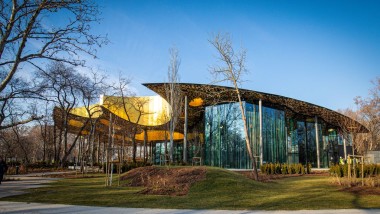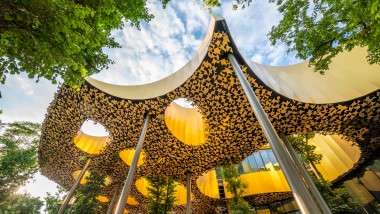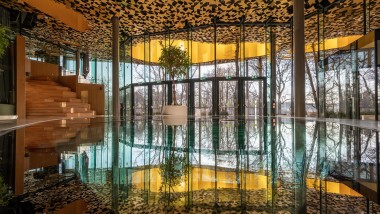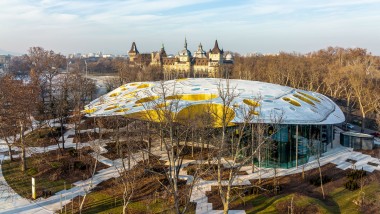This is where the music plays House of Music Hungary, Budapest (HU)
The “House of Music Hungary“ in the historic park of the Hungarian capital Budapest creates harmony between nature and art with ease. Its architecture is an invitation to all city dwellers to enter and listen.
A gigantic mushroom seems to shoot out of the ground in the city park of Budapest. It grows between and around the trees. It is Japanese architect Sou Fujimoto's answer, cast in architecture, to the question: What does it mean to build a new building in a historical park?
Experiencing the park indoors
Whoever enters the 9,000 sqm culture house with concert rooms, a museum, a library as well as numerous workshop rooms will have one foot in Budapest's 200-year-old park, at least in the entrance area. Sou Fujimoto was inspired by the shape of sound waves when designing the roof structure. At the same time, the playfully undulating canopy is perforated by about 100 crater-like recesses of different shapes and sizes in which park trees grow. The roof construction ensures that the building blends harmoniously into its surroundings.
The boundary between inside and outside blurs in this building, however, not only vertically but also horizontally. The façade consists of 94 thermally insulated glass panels that are up to 12 metres high. Concertgoers are thus always surrounded by nature, even in the transparent entrance hall.
Open to all
Just as the park continues to grow in the building, the art of this cultural institution continues to have an effect in the park. This is ensured by the open-air stages, which are protected by the roof but open on all sides. In short, at some concerts you simply sit in the park.
The openness to nature, to the audience, is the programme of this cultural building. With its architecture, the “House of Music Hungary“ demonstrates that art and culture are part of the city and its everyday life, open and accessible to all.
Excellent design and sustainability
No wonder, the “House of Music Hungary“ has attracted the attention of the international architectural and cultural community. In 2019, it was named the best public architecture project in Europe at the prestigious International Property Awards competition in London, and in 2020 it won the Best Use Of Music In Property Development category at the American Music Cities Awards.
The sustainable concept of this building also attracted attention. It includes not only energy-efficient heating and cooling technology, but also maximum use of the natural resources of daylight and rainwater. Geberit contributed to efficient waste water disposal with the flushing and drainage systems. Additionally, Geberit supported the elegant interior design with the Selnova Comfort and Smyle
Facts
Geberit Know-how
Geberit Know-how
- Geberit Silent-db20 and Geberit HDPE drainage system
- Geberit Duofix installation system
- Geberit Sigma50 actuator plate
- Geberit Selnova Comfort WC and washbasin ceramic
- Geberit Smyle urinals
Image Gallery




Subscribe to eView The Geberit newsletter for architects
Around the world, Geberit products and solutions are used in buildings of all kinds. You will find a selection of the most interesting objects on this page.
Periodically, “eView“, the Geberit reference newsletter, takes up a current topic from the construction industry. In addition to spectacular project examples, “eView“ offers interviews with architects, construction experts and designers as well as further background information.